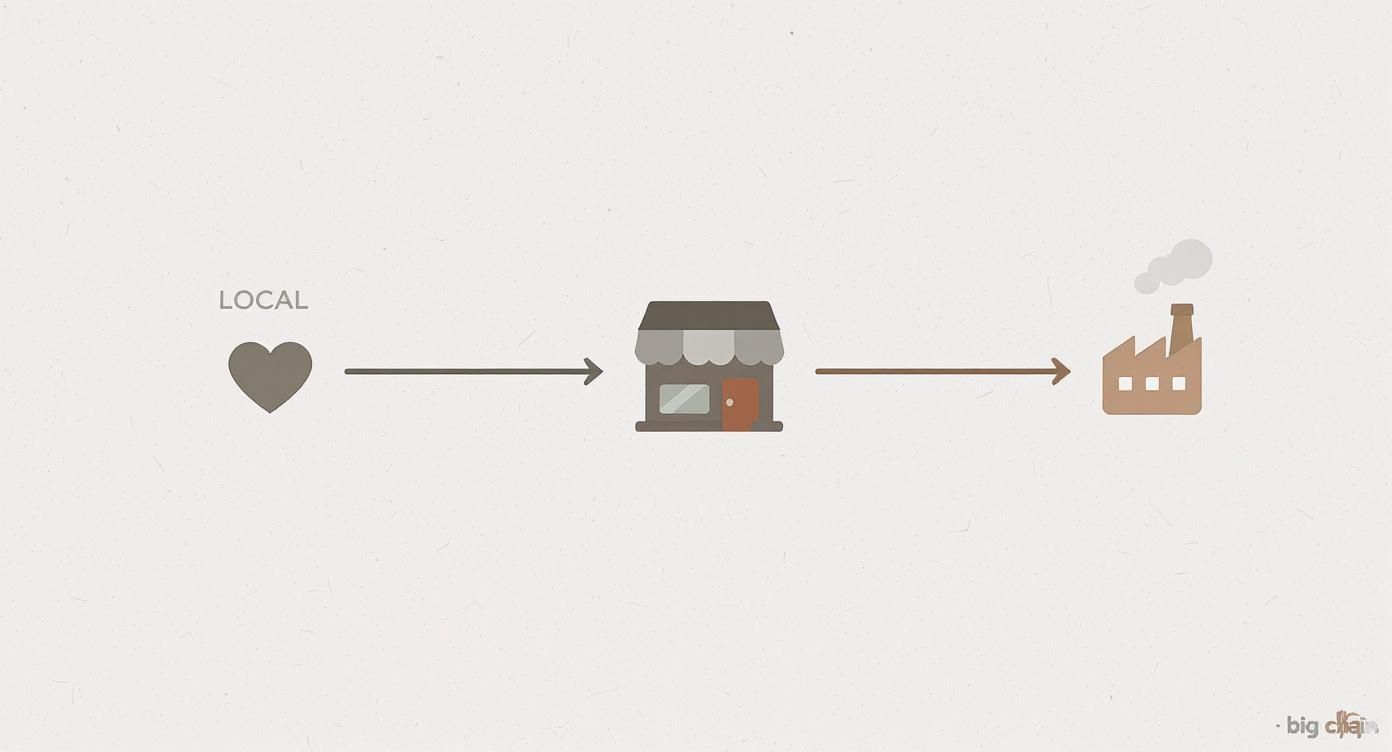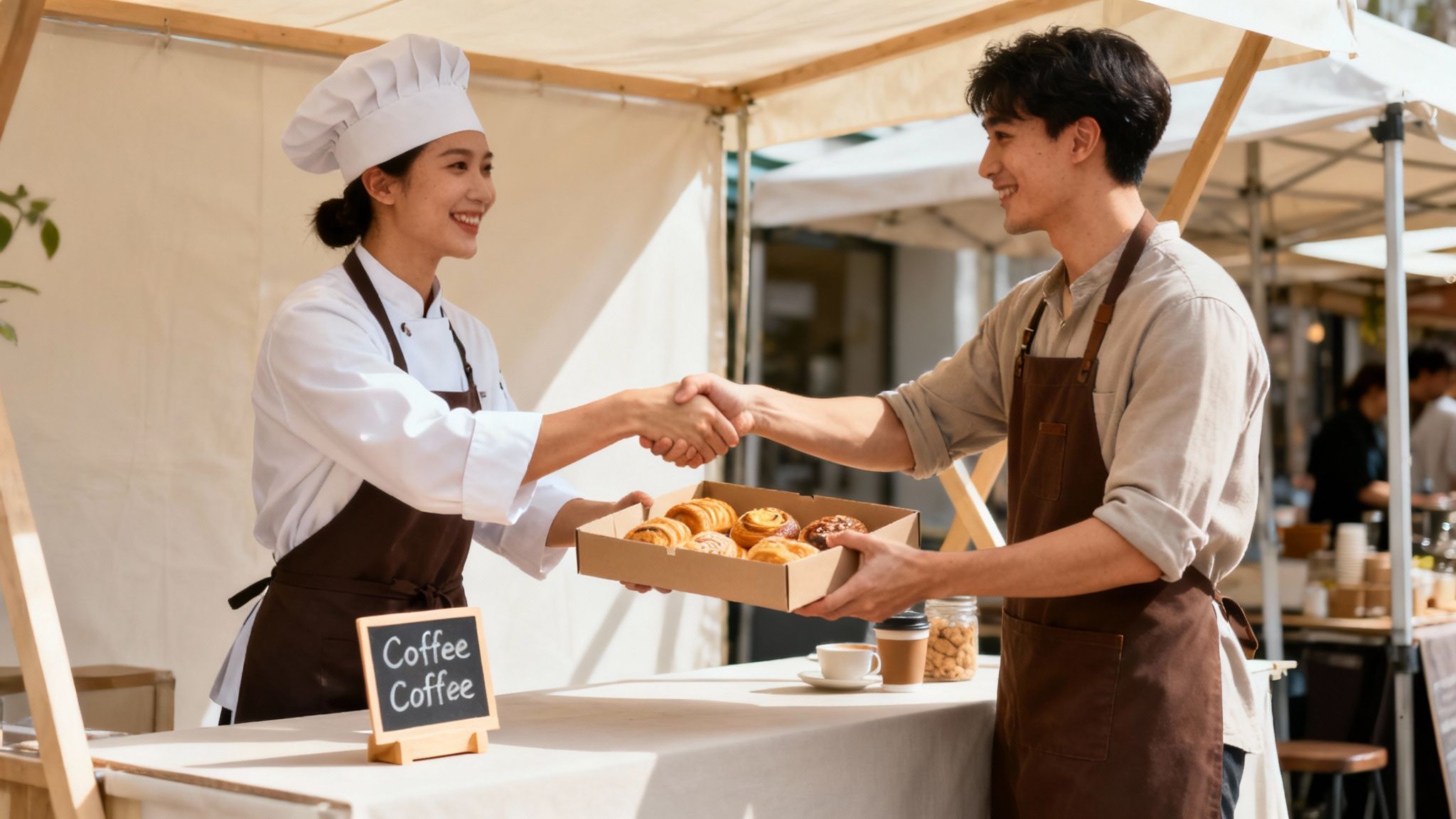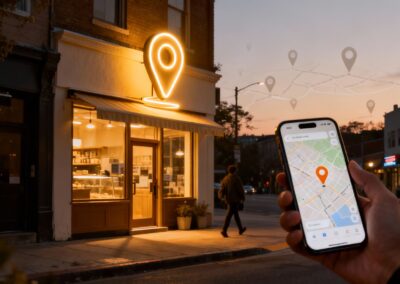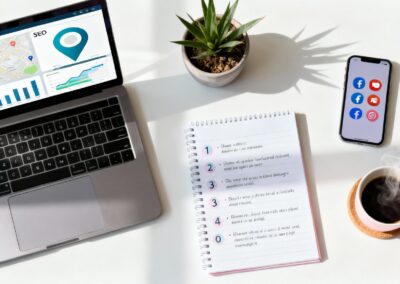So, what exactly is local marketing? Think of it as a strategy focused on attracting customers right in your neighborhood, town, or city. It’s all about using smart tactics, like local SEO and community events, to connect with people nearby who are already looking for what you offer. The goal is to become the obvious, go-to choice for the community right outside your door.
Why Local Marketing is Your Small Business Superpower
Picture a cozy neighborhood bookstore going head-to-head with a massive online retailer like Amazon. The giant has a monstrous budget and a household name, but the local shop has something far more powerful: a real, human connection to its community. It hosts events with local authors, greets customers by name, and stocks its shelves with books the neighborhood actually wants to read. That's the heart of local marketing.
It’s not about trying to outspend the big box stores; it’s about out-connecting them. For a small business, this isn't just another marketing plan—it's your superpower. You have the unique ability to be a trusted, familiar face in your community in a way a faceless national brand never can.
Redefining Your Marketing Focus
A lot of small business owners feel the pressure to compete on a national, or even global, scale. The problem is, that approach usually spreads your time, energy, and money way too thin. Smart local marketing means drawing a circle around your physical location and pouring all your efforts inside that circle. It's a fundamental shift from shouting into a crowded stadium to having meaningful conversations in your own backyard.
This focused approach is also incredibly efficient. You're reaching people who aren't just physically closer, but who are also far more likely to become loyal, repeat customers. A customer who lives five minutes away can easily stop by on a whim; someone across the country can't.
Your goal isn't to be known by everyone, everywhere. It's to become indispensable to the people right around you. This is how you build a sustainable business that thrives on community support and genuine relationships.
Building a Loyal Customer Base
This targeted strategy builds a kind of trust that national brands can only dream of. When customers see you sponsoring the local little league team, setting up a booth at a neighborhood festival, or teaming up with the coffee shop next door, you become more than just a business. You become part of the community's fabric. This creates a powerful advantage built on loyalty and goodwill that money just can't buy.
That connection leads directly to sustainable growth. Here’s how focusing on your immediate area builds such a strong foundation:
- Be Seen Where It Counts: You become the top result for "near me" searches, grabbing the attention of high-intent customers at the exact moment they need you.
- Spark Powerful Word-of-Mouth: Happy local customers turn into your best marketing team, telling their friends and neighbors all about their great experiences.
- Create Customers for Life: Local patrons are far more likely to come back again and again, turning a single sale into a long-term relationship.
At the end of the day, mastering local marketing is the most direct path to growth because it taps into your most valuable asset: your community.
Build Your Digital Foundation with Local SEO
Imagine your physical shop had the wrong address painted on the door or a broken, unreadable sign out front. You’d lose customers, right? That’s exactly what happens in the digital world without Local SEO. It’s the essential work of making sure when someone in your town searches for “pizza near me” or “best plumber in [Your Town],” your business is the one that pops up, clear as day.
At the heart of this entire strategy is your Google Business Profile (GBP). Don’t think of it as just another online listing. It’s your primary digital storefront on Google, the place where customers find your hours, see your photos, read reviews, and get directions—often before they even think about clicking through to your website.
Treating your GBP with the same attention you give your actual storefront is the first, most important step to winning at local marketing.
Claim and Optimize Your Google Business Profile
Getting your Google Business Profile right is non-negotiable. It’s a free, powerful tool that directly tells Google how, when, and where to show your business in Search and Maps. A complete and active profile is a huge trust signal for Google, telling the algorithm you're a legitimate business worth recommending.
The table below breaks down the must-have elements for a profile that gets results.
| GBP Feature | Why It Matters | Optimization Tip |
|---|---|---|
| Complete Information | Fills in the blanks for Google's algorithm and gives customers all the details they need. | Leave no field empty. Add services, attributes (like "women-owned"), accessibility info, and a detailed description. |
| High-Quality Photos | Builds trust and shows customers what to expect. People buy with their eyes first. | Upload clear, professional photos of your storefront (exterior and interior), products, your team, and happy customers. |
| Accurate NAP | Ensures customers and search engines have your correct contact info, preventing lost sales. | Triple-check that your Name, Address, and Phone number are 100% accurate and match across the web. |
| Google Posts | Acts like a free ad, highlighting offers, news, and events directly in search results. | Post weekly updates about promotions, new arrivals, or special events to keep your profile fresh and engaging. |
| Customer Reviews | Provides social proof that builds credibility and heavily influences your local ranking. | Actively encourage happy customers to leave reviews and always respond to feedback, good and bad. |
| Q&A Section | Pre-answers common questions, removing friction for potential customers. | Proactively add and answer your own FAQs to control the narrative and provide helpful info upfront. |
By checking off every item in this table, you're not just filling out a form; you're building a powerful customer acquisition tool.
The infographic below illustrates how small, local businesses can effectively compete with bigger chains by playing to their strengths.

As you can see, your superpower isn't a massive budget; it's your ability to build genuine community trust and personal connections.
The Critical Importance of NAP Consistency
One of the cornerstones of Local SEO is something we call NAP consistency. NAP stands for your Name, Address, and Phone number.
Think of it this way: if you gave out three different phone numbers for your shop, people would get confused and eventually give up. Search engines get just as confused.
When your business name, address, and phone number are perfectly identical everywhere online—from your website to social media to niche directories—it builds incredible trust with Google. Even tiny differences, like writing "St." in one place and "Street" in another, can muddy the waters and hurt your ranking.
A consistent NAP across the web is the bedrock of local search authority. It confirms your location and legitimacy, making it easier for Google to rank you in local map packs and "near me" searches.
This consistency is the green light that tells search engines you are exactly who and where you claim to be. For a deeper look at getting this right, check out our complete guide on how to improve local SEO.
Turning Your Profile into a Customer Magnet
A truly optimized GBP is more than just an information hub; it's an active tool for engaging customers. Google gives you a suite of features to turn casual searchers into paying customers, and using them is key.
The numbers don't lie. Local searches now account for around 46% of all searches on Google. Even more telling, a staggering 88% of people who search for a local business on their phone will call or visit a store within 24 hours. And with 89% of U.S. consumers saying they're more likely to use a business that responds to its online reviews, the message is clear: engagement drives business.
Put your profile to work for you by:
- Using the Q&A Feature: Get ahead of customer questions. You can even post and answer your own FAQs to provide valuable information right away.
- Creating Google Posts: Think of these as free, mini-ads on your profile. Share updates, announce sales, or highlight a new product.
- Encouraging and Responding to Reviews: Don't be shy about asking happy customers for a review. And make sure you reply to all of them, positive and negative. It shows you're listening and you care.
This is the foundational work that turns online visibility into real-world results: more foot traffic, a ringing phone, and a loyal customer base.
Engage Your Community with Authentic Content
Once local customers can find you online, the next step is to make them want to connect with you. Great local marketing isn't just about being visible; it's about building a genuine community, not just a customer list. This is where authentic content becomes your secret weapon for turning casual browsers into loyal fans.
Forget the generic corporate-speak. Your content should feel like it's coming from a neighbor, not a boardroom. It’s about sharing stories, celebrating local culture, and becoming the go-to resource people in your town trust. That’s how you build an emotional connection that the big, faceless brands just can't touch.

Speak Like a Neighbor, Not a Corporation
The real trick is to let the personality of your town shine through in your content. If you're in a funky, artistic neighborhood, your social media should buzz with that same energy. If your shop is in a quiet, family-focused suburb, your tone should be warm and inviting. Ditch the stiff, formal language and just talk to people.
Your content is your digital handshake. Make it warm, authentic, and memorable. When you show genuine passion for your community, your community will show its passion for you.
This mindset shift is everything. People are tuning out blanket promotions and looking for businesses that actually get their local pride. In fact, a whopping 63% of consumers want businesses to get more involved with community issues and events. Creating that hyper-local connection is what makes a small business stand out. You can learn more about trends shaping local marketing success and see just how powerful this focus can be.
Actionable Ideas for Community Content
Creating content that truly connects doesn't need to be complicated or expensive. It just needs to be real. Here are a few simple but powerful ideas to get you started on social media and your blog.
- Run a Local Photo Contest: Ask your followers to share photos of their favorite local spot using a unique hashtag. The prize can be as simple as a gift card to your store. Feature the winning shots on your profile—it's great content for you and a fun contest for them!
- Highlight Other Local Businesses: Give a shout-out to a non-competing business you love, like the coffee shop next door or that cool new boutique down the street. It builds goodwill and strengthens the entire local business scene.
- Share Behind-the-Scenes Glimpses: People love seeing the humans behind the business. Post short videos of your team at work, prepping a product, or even just sharing a laugh. It builds trust and makes your brand so much more relatable.
- Use Hyper-Local Hashtags: Think beyond the obvious tags. Use hashtags for your specific neighborhood, city, or a popular local event (think
#YourTownFarmersMarketor#YourNeighborhoodArtWalk). This puts you right in front of people already engaged with your community.
Become a Helpful Local Resource
One of the absolute best ways to build trust is to create content that helps your community, with zero expectation of an immediate sale. Your blog is the perfect place for this. When you position yourself as a helpful local expert, you become the first person people think of and recommend.
Try to answer the questions your customers might have about your area, not just your products. This is a cornerstone of smart local marketing for a small business because it establishes you as an authority and builds incredible goodwill.
Here are a few blog post ideas that provide real value:
- A sporting goods store could write: "Our Top 5 Family-Friendly Hiking Trails in [Your County]"
- A café or bakery could post: "The Best Picnic Spots Within 10 Miles of [Your Town]"
- A hardware store might publish: "A Seasonal Guide to Gardening in [Your State]'s Climate"
This kind of content shows you care about your customers' lives, not just their wallets. It cements your place as a valued part of the community, ensuring that when they do need what you sell, your business is the one that comes to mind.
Amplify Your Reach with Local Partnerships
Some of your best marketing assets aren't online at all. They're the other small businesses right down the street. Local partnerships are all about bridging your digital marketing with the real world, creating powerful win-win scenarios that help everyone, especially your customers.
Think about a local bakery teaming up with the coffee shop next door for a "Morning Commuter Special." Or picture a yoga studio co-hosting a wellness workshop with the health food store on the corner. These collaborations just make sense to customers. They introduce your brand to a new, relevant audience that already trusts your partner. It’s a brilliant way to build community and drive sales at the same time.

Finding Your Perfect Partners
The secret to a great partnership? Finding a non-competing business that serves the exact same type of customer as you, just with a different product or service. This alignment is what makes the collaboration feel authentic instead of forced.
Start by just brainstorming businesses that naturally complement what you do. A real estate agent could partner with a local mortgage broker or a home staging company. A children's clothing boutique could easily team up with a family photographer.
The most powerful local partnerships feel like a natural extension of your brand. They offer combined value that neither business could provide alone, making life easier and better for the customer.
Once you have a list of potential businesses, reach out with a clear idea that benefits both of you. Frame it as a way to grow together. The goal isn't a one-off promotion; it's about building genuine relationships that lead to long-term success.
Creative and Mutually Beneficial Campaigns
After you’ve found the right partner, it’s time for the fun part. Your joint marketing efforts don't need to be complicated or expensive; in fact, simple ideas often work best. One fantastic way to grow your local influence is by working with community figures; you can discover how to find local influencers who already have the trust of your ideal customers.
Here are a few practical ideas to get you started:
- Co-Host an Event: Plan a joint workshop, a customer appreciation night, or a seasonal pop-up. You'll pool your resources and double your promotional reach instantly.
- Create a Bundled Offer: Package your products or services together for a special price. Imagine a spa and a hair salon offering a "Total Relaxation" package.
- Run a Cross-Promotion: Offer a small discount to customers who show a receipt from your partner business, and have them do the same for you. It's simple and effective.
- Share Social Media Content: Feature each other on your social media accounts. You could do a day-long Instagram "takeover," give each other shout-outs, or run a joint giveaway.
Get Involved in Community Events
Beyond one-on-one partnerships, truly embedding your business in the community builds a level of goodwill that ads simply can't buy. Participating in local events puts you face-to-face with potential customers in a friendly, low-pressure setting.
Consider setting up a booth at a street festival or sponsoring a local youth sports team. These actions show you care about the community's well-being, not just its wallet. And the impact is real. Community-focused events like Small Business Saturday have generated an estimated $201 billion in spending since 2010, with about $17 billion spent in 2023 alone. This proves just how much people value supporting businesses that are a genuine part of their local fabric.
Build Trust by Managing Online Reviews
https://www.youtube.com/embed/oB_xL4FiM2Q
Think of online reviews as today's version of word-of-mouth. It's a public conversation about your business that’s happening 24/7, and it has the power to either make or break you. For a small business, your reputation is your currency, and managing it starts with listening to what people are saying online.
This isn't just about putting out fires. It's about building a public record of trust. When a potential customer sees you responding to reviews—both the good and the bad—they see a business that listens, cares, and is committed to getting it right. That kind of proactive engagement can set you miles apart from the local competition.
How to Encourage Customer Feedback
Getting a steady stream of positive reviews is a huge advantage, but you have to be smart about how you ask. Nobody likes being pestered. The secret is to make it incredibly easy and to ask at the perfect moment—right after a fantastic experience.
Here are a few simple, non-pushy ways to do it:
- Strike While the Iron is Hot: The absolute best time to ask for a review is right after you’ve delivered great service or solved a problem. A simple follow-up email with a direct link or even a QR code on a receipt works wonders.
- Use Simple Signage: A small, friendly sign at your checkout counter or front desk with a QR code to your Google Business Profile is an easy, passive reminder for happy customers.
- Personalize the Ask: When a customer gives you a compliment in person, that's your cue! A simple, "Thank you so much! We'd be so grateful if you shared that feedback on Google. It really helps others find us," feels genuine and effective.
Engaging with reviews, both good and bad, doesn't just solve individual issues. It builds a public history of excellent customer service that becomes one of your most powerful marketing assets.
Responding to Every Single Review
Responding to reviews is non-negotiable. It shows you value customer opinions and are an active, engaged business owner. More importantly, it shows every potential customer how you handle feedback, which is a massive factor in their decision-making process.
The Good: The Positive Review
When someone leaves a glowing review, a generic "Thanks!" just doesn't cut it. Acknowledging their specific comments shows you actually read and appreciate what they took the time to write.
- Acknowledge Specifics: Mention the detail they loved. "We're so glad you enjoyed the seasonal latte!"
- Reinforce Your Values: "We work hard to create a welcoming space, so it's great to hear you felt right at home."
- Invite Them Back: A simple "We can't wait to see you again soon!" goes a long way.
The Bad: The Negative Review
A negative review can feel like a punch to the gut, but your public response is what truly matters. Remember, you aren't just replying to the unhappy customer; you're speaking to every future customer who reads it. Our guide on online reputation management best practices offers a much deeper dive into this critical skill. To stay on top of the conversation, you can also explore the best online reputation management tools available.
Here’s a simple framework for your response:
- Acknowledge and Apologize: Start with a sincere apology for their poor experience. No excuses.
- Take It Offline: Provide a direct way for them to connect with you to resolve the issue privately. "We'd like to learn more. Please email our manager at…"
- Don't Get Defensive: Never, ever argue in the comments. Keep your public response professional, calm, and brief.
7. Measure The Results That Actually Matter
So, you’ve put in the work. How do you know if any of it is actually paying off? The good news is you don’t need a complicated dashboard or an analytics degree. It’s all about focusing on the simple actions that ring your phone and fill your appointment book.
Let's cut through the noise and look at the key metrics that show your local marketing is translating clicks into real, paying customers. We'll use the free insights you already have from your Google Business Profile and a few other simple tools to connect every effort to your bottom line.
Key Google Business Profile Metrics
Your Google Business Profile (GBP) is a goldmine of data that tells you exactly how people are finding and interacting with you. Instead of getting lost in vanity metrics, zero in on these three actions:
- Phone Calls: This is as direct as it gets. How many people saw your profile and decided to call you right then and there?
- Direction Requests: This metric shows pure intent. Someone literally asked their phone for a map to your front door.
- Website Clicks: These are visitors who came to your site directly from your GBP listing, already warmed up and interested in what you offer.
Beyond your GBP dashboard, it’s smart to peek at your website's analytics. Look specifically at local search traffic—that is, organic visits from your specific town, city, or zip code. This tells you if you're capturing the attention of the people who can actually walk through your door.
Social media engagement is another great signal. Keep an eye on likes, shares, and especially local mentions or check-ins. It's the digital version of word-of-mouth and a fantastic indicator of community buzz.
Essential KPIs for Local Marketing
To make this even clearer, let's organize the most important metrics into a simple table. This is your cheat sheet for tracking what truly matters. Think of it as your local marketing report card.
| Metric | What It Measures | Where to Find It |
|---|---|---|
| Phone Calls | The number of direct phone inquiries from your listing. | Google Business Profile Insights |
| Direction Requests | How many people requested a map to your location. | Google Business Profile Insights |
| Website Clicks | The volume of clicks from your GBP to your website. | Google Business Profile Insights |
| Local Sessions | Website visits from users in your target geographic area. | Google Analytics |
| Social Engagement | Local likes, comments, shares, and check-ins. | Your Social Media Platform Insights |
Tracking these numbers consistently gives you a clear, honest picture of your performance. You'll quickly see which channels are driving real-world action and which might need a little more attention.
Building a Simple Measurement Plan
Now, let's put those metrics to work with a straightforward plan you can actually stick to.
- Define Your Goals: Don't try to track everything. Pick 2–3 core metrics that matter most to you (like calls and direction requests) and set a realistic monthly target.
- Review Weekly: Block out 15 minutes each week to pop into your GBP and analytics dashboards. Just jot down the numbers and see how you’re pacing toward your monthly goal.
- Adjust Your Tactics: Are calls lagging behind your target? Maybe it's time to create a new GBP post with a compelling offer. Are website clicks low? Try adding some new photos. Small, consistent tweaks can lead to big improvements.
"A ringing phone tells you more than a thousand clicks ever will."
Don't Forget to Track Offline Conversions
Let's be honest, not every customer journey starts and ends online. A customer might see your Facebook ad, drive by your store, and then finally walk in a week later. How do you track that?
You have to connect the dots by asking.
- Ask at Checkout: Train your staff to simply ask, "How did you hear about us?" and make a quick note. You'll be amazed by what you learn.
- Use Promo Codes: Create unique discount codes for different channels (e.g., "FACEBOOK10" or "GOOGLE15"). When a customer uses a code, you know exactly where they came from.
- Log Your Appointments: When booking an appointment, ask what prompted them to call. A quick note in your calendar—"saw Google review"—can provide invaluable insight.
These simple offline checks close the loop, giving you the full story of how customers find you. This clarity makes it easy to celebrate what's working and confidently decide where to invest your time and money next. When you can show your team that a specific campaign led to 15 new appointments, that’s when motivation soars and your next steps become crystal clear.
Frequently Asked Questions
It's natural to have questions when you're diving into local marketing. Let's tackle some of the most common ones I hear from small business owners so you can move forward with confidence.
How Much Should a Small Business Budget for Local Marketing?
This is a big one, and the good news is you don't need a massive budget to make an impact. The smartest way to start is by focusing on the powerful, free tools right at your fingertips.
First, pour your energy into fully optimizing your Google Business Profile and getting active with your community on social media. These things cost you nothing but a bit of time, and they build an essential foundation for everything else.
When you're ready to dip into paid ads on Google or Facebook, start small and stay in control. Think $5 to $10 a day. The goal isn't to outspend everyone; it's to test what resonates with your audience. See what campaigns actually make the phone ring or bring people through the door. Once you find a winner, you can confidently reinvest your profits back into what's proven to work.
What Is the Single Most Important First Step in Local Marketing?
If you do only one thing, do this: claim and completely optimize your Google Business Profile (GBP). Seriously. Before you spend a single dollar on ads or a single hour on a blog post, this is your priority.
Think of your GBP as your digital front door. For most potential customers searching online, it's the very first impression they'll have of your business.
Your Google Business Profile is the bedrock of all your other local marketing efforts. A complete and accurate profile is the single most powerful free tool you have to attract nearby customers.
Nail every detail. Make sure your contact info is perfect, upload high-quality photos, list all your services, and have a simple process for encouraging new reviews. A well-tended GBP is the engine that drives visibility, calls, and foot traffic.
How Long Does It Take to See Results From Local SEO?
Local SEO is a marathon, not a sprint. While some tweaks, like updating your store hours on your GBP, show up instantly, the real goal—climbing the search rankings and seeing more organic traffic—takes time and consistent effort.
Generally, you can expect to see real, noticeable momentum within 3 to 6 months of steady work. That means consistently earning new reviews, publishing Google Posts, and making sure your business information is accurate everywhere online. Over time, these actions build trust with search engines, and that trust is what gets you ranked higher.
If you need a faster boost, paid local ads are your best bet. They can drive leads and calls almost immediately, giving your business a shot in the arm while your long-term organic strategy builds strength in the background. It's a powerful one-two punch for growth.
Ready to stop guessing and start growing? At Digital Lotus Marketing, we build local marketing strategies that deliver real, measurable results for small businesses like yours. We handle the complexities so you can focus on what you do best—running your business.






